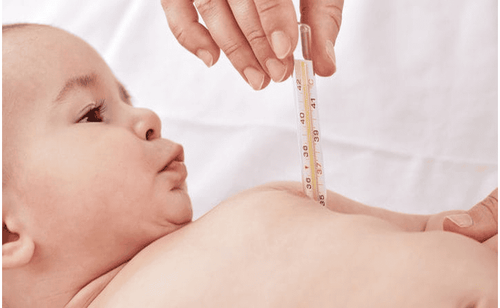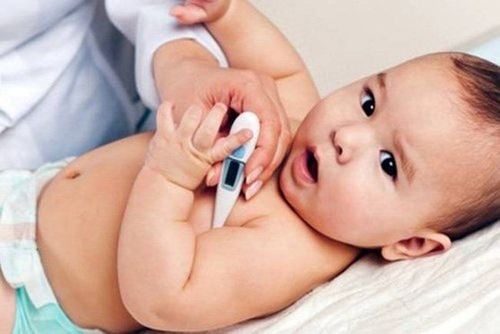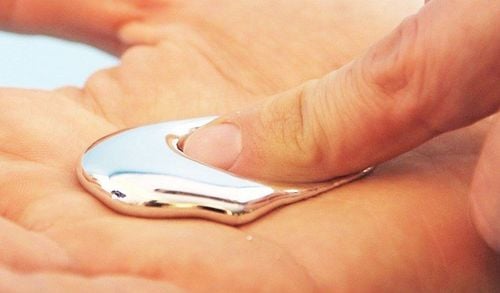This is an automatically translated article.
Human body temperature can change rapidly. If a child or someone else is sick, caregivers need to know how to monitor body temperature. Therefore, knowing how to measure mercury thermometer accurately and safely at home will help monitor health and take better care of patients.
Here are the steps to measure mercury thermometer accurately and safely:
1. Have the thermometer ready before use
Compared with mercury thermometers, it is safer to choose to use mercury-free glass thermometers. It says on the packaging whether this device contains mercury, so read it carefully before purchasing the product. However, as long as there is a thermometer ready before use, check the thermometer to make sure there are no cracks or leaks, a mercury thermometer is also a safe tool to monitor health at home. .
How to measure a mercury thermometer starts with choosing between a rectal or an oral thermometer. These thermometers feature different shapes to help the patient feel more comfortable. Specifically, rectal thermometers have a rounded tip, while oral thermometers have a more pointed tip.
Before measuring the temperature, it is necessary to clean the thermometer with soap and water. Use cool water and hand soap to clean the thermometer's glass cover. Be sure to rinse the tool thoroughly under running water to remove soap residue. The use of hot water should be avoided, as excessive heat can break the thermometer. Another possible way to clean the thermometer is to wipe it thoroughly with rubbing alcohol, then rinse.
Compared to measuring the electronic thermometer, the way to measure the mercury thermometer has the difference that it is necessary to shake the thermometer to reduce the temperature. This is because the glass thermometer does not always return to its original position by itself after measuring the temperature. It is therefore important to grasp one end of the thermometer and shake it vigorously to ensure that the temperature falls below at least 36.0°C, i.e. below average body temperature. However, this movement needs to be very careful, do not let the thermometer collide with anything while shaking, because it can break the glass and lead to mercury poisoning.

Dấu hiệu bị nhiễm độc thủy ngân
2. How to measure mercury thermometer
2.1. Rectal Temperature This is a mercury thermometer for infants or children 3 years of age and younger.
Before inserting the thermometer into the rectum of young children, to avoid causing discomfort, parents should lubricate the measuring head with a little lubricant or moisturizing oil. Then place the child on his or her back, raise the legs, and gently push the probe into the rectum, about 1.3 to 2.5 cm. Do not press firmly on the thermometer if it feels clogged. Keep the thermometer in place for the duration of the measurement to avoid allowing the instrument to go deeper into the child's body. Moreover, parents also need to keep the baby still or hold the baby so that the thermometer does not break.
2.2. Oral temperature measurement Oral temperature measurement is more suitable for adults and children over 4 years of age.
How to do it is to place the tip of the thermometer under the tongue, towards the back of the mouth. The measurer himself can hold the instrument in place by closing his lips.
This method is relatively accurate for taking body temperature but can be difficult for some children. Because the child is at risk of biting and breaking the thermometer.
For the most accurate oral mercury thermometer reading, wait 15 minutes before taking your temperature if you've eaten or drank anything.
2.3. Taking temperature in the armpit Placing an armpit thermometer is also a way to take a mercury thermometer to easily estimate body temperature. This position can use an oral or rectal thermometer. Raise one arm and place the thermometer in so that the tip is in the center of the armpit. Ask the patient to focus on keeping the arm close to the body during the measurement to ensure accurate results as well as to avoid dropping the thermometer.
In case the mercury thermometer reading shows the person has a fever, check again by reading the thermometer rectal or oral, depending on the age of the sick person. This is because the armpit is not an accurate place to record body temperature, while the results of a mercury thermometer for babies are important to quickly determine whether a child has a fever or not.

Cách đo nhiệt kế thủy ngân cho trẻ sơ sinh đúng cách
3. How to read the results on a mercury thermometer
After keeping the thermometer in place for 2-4 minutes with the amount of time depending on the measurement location, the thermometer can be taken out and observed to record the results. If you are using a rectal thermometer, holding it for 2-3 minutes should be enough. Meanwhile, if taking the temperature in the mouth or armpit, need to leave the thermometer in place for 3-4 minutes.
Try not to shake the thermometer when removing it from the body as this may affect the measurement results. Hold the thermometer horizontally to read the numbers. Bring the tool body to eye level, each division corresponds to 0.1°C. Read the nearest number at the position to the end of the mercury tree.
After reading the results, it must be determined whether the patient has a fever. Generally, a person is considered to have a fever if the temperature is at or above 38.0 °C when measured rectally or orally and above 37 °C if measured under the arm.
A doctor should be called if:
A child under 3 months of age has a fever based on rectal temperature readings. If your baby is 3-6 months old with a fever of 39°C and other symptoms such as lethargy or irritability, notify your doctor immediately. If a baby's temperature between 6 and 24 months is 39°C, call the doctor if it persists for more than 1 day. Finally, clean the thermometer before storing it away. Rinse the instrument with cool water and soap, scrubbing the length of the thermometer but focusing specifically on the tip. Rinse thoroughly with water when finished because, if not cleaned carefully, the way the mercury thermometer is measured can also be a way of spreading germs to the next person or next use.
In short, although there are different types of modern thermometers today, the way to measure mercury thermometers is still very popular. By simply taking the step-by-step safety precautions mentioned above, this device will help monitor body temperature while caring for someone who is sick or has a fever.
References: eastmoaa.org, miriamstoppard.com, my.clevelandclinic.org, verywellhealth.com













